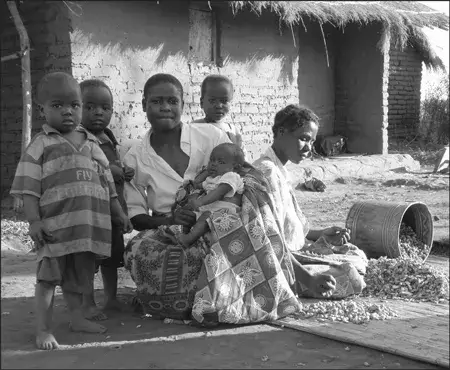This is a tale of two families. The first is my lab manager’s family, which is shown on its original homestead in Seguin, Texas, in 1910 (see Figure 1). Two of the eight children – the two little ones in the front – died before they turned five. These two children, if born today, would most certainly live to adulthood, but at the time, two in ten children in the United States did not live to see their fifth birthday. The second family, shown in a photograph I took recently, lives in rural Malawi (see Figure 2). Despite significant reductions in global child mortality, the chances of these children perishing in Malawi today are approximately the same as those in the United States in the 1930s.

Although global child mortality has dropped by 50 percent since 1990, neonatal mortality has declined much more slowly. Newborns now represent more than 40 percent of under-five deaths,1 and preterm birth is the world’s leading killer of children.2 Multiple evidence-based global health priority setting exercises recommended strengthening hospital care for small and sick babies.3 Despite these calls for action, at current rates of progress, it will be 150 years before a baby born in Africa has the same chance of survival as one born in North America.4

In the United States, neonatal intensive care units (NICUs) played a key role in reducing newborn death rates;5 when regional NICUs were introduced in the 1960s, neonatal mortality fell by 60 percent.6 Modern NICUs combine excellent clinical care with advanced medical technology to address the needs of small and sick babies. In contrast, a typical newborn unit at a community hospital in Africa is staffed by dedicated clinicians but lacks even the most basic medical technology, such as oxygen concentrators or radiant warmers.
Even with its stunning consequences for African families, this technological gap persists for two reasons. First, equipment designed for use in a high-resource setting simply fails in Africa due to harsh environmental conditions, complex maintenance requirements, or from the lack of stable infrastructure, such as consistent electricity.7 Donated equipment thus ends up in “graveyards”: stockpiles of expensive but unsuitable technologies. Second, there is no viable business model for producing and delivering these technologies. Multinational med-tech companies lack sufficient commercial incentive, while local entrepreneurs lack access to biomedical expertise and necessary facilities to fill this gap.8 Without efforts to provide affordable, appropriate technologies, and build local capacity to support and sustain their adoption, one million African newborns will continue to die unnecessarily each year.
Three key actions are needed to address the persistent global challenge of newborn death. The first is to develop a set of affordable, rugged technologies that enable quality comprehensive newborn care in low-resource settings. Eighty-five percent of newborn deaths in low-resource settings are the result of three causes: complications of labor and delivery, infections, and prematurity. The majority of these deaths could be prevented using seventeen simple technologies, such as tools to keep babies warm, to help them breathe, to monitor labor and delivery, to diagnose jaundice and other conditions, and to deliver fluids and medications safely.9 Yet, current coverage is low; the needed technologies are simply not available.10 A growing community of innovators is beginning to address this need. Using principles of frugal design, engineers are developing appropriate technologies that are as effective as those in high-resource settings but cost between ten to a hundred times less. These technologies are designed to function in harsh environmental conditions, to meet international regulatory standards, to last more than five years, and to require no skilled maintenance and only inexpensive parts. For example, we designed a rugged, low-cost bubble continuous positive airway pressure (CPAP) system to help premature babies breathe. This CPAP system delivers the same flow and pressure as alternatives used in high-resource settings but at a ten-fold cost reduction.11 Its use improved survival for premature babies suffering from respiratory distress syndrome from 24 percent to 65 percent,12 mirroring the improvement seen when CPAP was introduced in the United States. Licensed to industry with preferred pricing in low-resource settings, the system has received international regulatory approval and is now being used in more than twenty countries.13
Second, new technologies must be introduced in parallel with appropriate clinical education programs to ensure that they are used safely and effectively; but they must also be paired with appropriate technical education programs to ensure that technologies can be maintained and repaired. In particular, support for technical education programs in sub-Saharan Africa has lagged and there is an important need to build capacity. For example, a recent report from the Royal Academy of Engineering, which focused on identifying engineering capacity needs in the region, noted that the number of engineers emigrating annually from South Africa in the early 2000s matched the number of engineers graduating.17 Strengthening technical education programs can lead to immediate improvements in health outcomes. For example, we developed low-cost phototherapy lights to treat newborn jaundice, which, in a randomized controlled study, were shown to deliver therapy equivalent to traditional methods18 and at a significant cost reduction. We worked with engineers at Malawi Polytechnic to improve the design for local manufacture, and the lights are now being manufactured in Malawi and distributed through partnerships between the local engineering and medical school.Other groups are using similar approaches to improve maternal and newborn health in low-resource settings. For example, Burke and colleagues developed an ultra-low-cost kit (less than $5) to prevent maternal death from postpartum hemorrhage, a condition that accounts for more than 30 percent of global maternal deaths. Their ingenious approach, using locally available materials, reproduces the expensive uterine balloons used in high-resource settings to stop blood loss: they use a condom tied to a Foley catheter that is then inflated with clean water through a syringe and one-way valve. Clinical evaluation of the system in five African countries shows that the system rapidly and effectively controlled blood loss in hemorrhaging women.14 Similarly, the non-profit Laerdal Global Health recently developed a low-cost fetal heart rate monitor designed to improve safe monitoring of labor in low-resource settings that lack access to traditional electronic monitoring systems.15 A clinical trial is underway in Tanzania, comparing the automatic use of the low-cost monitor to that of a hand-held Doppler ultrasound for detection of an abnormal fetal heart rate.16
Finally, new business models are needed to sustain the delivery of medical technologies and supplies to low-resource settings. Collaborations with private-sector partners who can support manufacturing, regulatory affairs, and sales and distribution are needed to sustain improvements in care. Economic analyses that document the health benefits of investments in technology are needed to incentivize both private sector and government investment in strengthening capacity for facility-based newborn care.
It is possible to end preventable death in Africa – not in 150 years but in a decade – if we create a supportive ecosystem of well-trained clinicians, inventors, and entrepreneurs working together to transform the ability of community hospitals across Africa to ensure that every newborn has a chance at a healthy life.
Rebecca Richards-Kortum is Malcolm Gillis University Professor, Professor of Bioengineering, Professor of Electrical and Computer Engineering, and Director of Rice 360°: Institute for Global Health at Rice University. She was elected a Fellow of the American Academy of Arts and Sciences in 2015.
© 2017 by Rebecca Richards-Kortum
ENDNOTES
1. L. Liu, H. L. Johnson, S. Cousens et al., “Global, Regional, and National Causes of Child Mortality: An Updated Systematic Analysis for 2010 with Time Trends since 2000,” Lancet 379 (9832) (2012): 2151–2161.
2. J. E. Lawn and M. Kinney, “Preterm Birth: Now the Leading Cause of Child Death Worldwide,” Science Translational Medicine 6 (263) (2014): 263ed21.
3. M. V. Kinney, O. Cocoman, K. E. Dickson et al., “Implementation of the Every Newborn Action Plan: Progress and Lessons Learned,” Seminars in Perinatology 39 (5) (2015): 326–337; J. E. Lawn, R. Davidge, V. K. Paul et al., “Born Too Soon: Care for the Preterm Baby,” Reproductive Health 10 (Suppl. 1) (2013): S5; Z. A. Bhutta, J. K. Das, R. Bahl et al., “Can Available Interventions End Preventable Deaths in Mothers, Newborn Babies, and Stillbirths, and At What Cost?” Lancet 384 (9940) (2014): 347–370; and J. E. Lawn, “The Child Survival Revolution: What Next?” Lancet 384 (9947) (2014): 931–933.
4. G. L. Darmstadt, D. A. Oot, and J. E. Lawn, “Newborn Survival: Changing the Trajectory over the Next Decade,” Health Policy and Planning 27 (Suppl 3) (2012): iii, 1–5.
5. P. Dupas, “Getting Essential Health Products to Their End Users: Subsidize, But How Much?” Science 345 (6202) (2014): 1279 – 1281.
6. A Symposium Commemorating Child Health Day, NIH Publication No. 92–2786 (Bethesda, MD: U.S. Department of Health and Human Services, Public Health Service, National Institutes of Health, 1992).
7. L. Perry and R. Malkin, “Effectiveness of Medical Equipment Donations to Improve Health Systems: How Much Medical Equipment is Broken in the Developing World?” Medical & Biological Engineering & Computing (July 2011).
8. D. Niemeier, H. Gombachika, and R. Richards-Kortum, “How to Transform the Practice of Engineering to Meet Global Health Needs,” Science 345 (6202) (2014): 1287–1290.
9. K. R. Maynard, L. Causey, K. Kawaza et al., “New Technologies for Essential Newborn Care in Under-Resourced Areas: What is Needed and How to Deliver It,” Paediatrics and International Child Health 35 (3) (2015): 192–205.
10. Bhutta, Das, Bahl et al., “Can Available Interventions End Preventable Deaths in Mothers, Newborn Babies, and Stillbirths, and At What Cost?”
11. J. Brown, H. Machen, K. Kawaza et al., “A High-Value, Low-Cost Bubble Continuous Positive Airway Pressure System for Low-Resource Settings: Technical Assessment and Initial Case Reports,” PLoS ONE 8 (1) (2013): e53622.
12. K. Kawaza, H. E. Machen, J. Brown et al., “Efficacy of a Low-Cost Bubble CPAP System in Treatment of Respiratory Distress in a Neonatal Ward in Malawi,” PLoS ONE 9 (1) (2014): e86327.
13. Hadleigh Health Technologies, http://hadleighhealthtechnologies.com/pumani-bcpap/; accessed February 14, 2017.
14. T. F. Burke, R. Ahn, B. D. Nelson et al., “A Postpartum Haemorrhage Package with Condom Uterine Balloon Tamponade: A Prospective Multi-Centre Case Series in Kenya, Sierra Leone, Senegal, and Nepal,” BJOG 123 (9) (2016).
15. Laerdal Global Health, http://www.laerdalglobalhealth.com/doc/2555/Moyo-Fetal-Heart-Rate-Monitor; accessed February 14, 2017.
16. National Institutes of Health, Clinical Trials Database, https://clinicaltrials.gov/ct2/show/NCT02790554; accessed February 14, 2017.
17. P. Matthews, L. Ryan-Collins, J. Wells, H. Sillem, and H. Wright, Engineers for Africa: Identifying Engineering Capacity Needs in Sub-Saharan Africa (London: Royal Academy of Engineering, 2012).
18. J. Viau Colindres, C. Rountree, M. A. Destarac et al., “Prospective Randomized Controlled Study Comparing Low-Cost LED and Conventional Phototherapy for Treatment of Neonatal Hyperbilirubinemia,” Journal of Tropical Pediatrics 58 (3) (2012): 178–183.